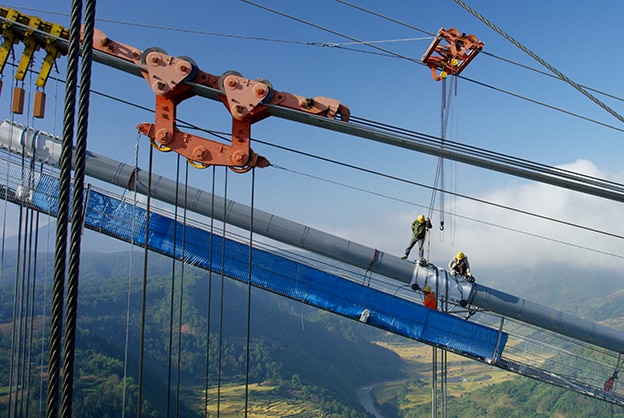Overview
STEM careers
Time
Materials
Per Whole Group:
|
Per Team:
|
Relevant Terminology
Critical load: The weight at which a structure will fail, or collapse.
Dead load: The weight of the structure itself.
Live load: The weight of everything supported by a structure except the structure’s own weight. For a building, this includes the people, furniture, computers, office supplies, telephones, and anything else inside or on it.
Structural integrity: The ability of a structure to support a designed load or weight without breaking, tearing, or collapsing.

The New York City skyline is dominated by skyscrapers. Advances in engineering allow for higher critical loads—which allows for taller buildings. Credit: David Jones/Wikimedia Commons.
Introduce
GETTING READY
Cut the base off each of the cardboard cartons. The base will be used as a platform for adding weight to the house of cards.
INTRODUCTION
Engineers must consider structural integrity (strength) and weight when designing a building or bridge. These structures need to support a certain amount of weight—including their own weight—and also stand up to forces from gravity, wind, and even earthquakes without failing. The term critical load is used to describe the amount of weight or force that causes a structure to fail, or fall apart.
The most efficient structures are designed to combine high structural integrity and low weight. This efficiency is an important consideration when deciding on materials for a structure. You may notice I-beams in bridges and buildings. I-beams, which are named for their cross-sectional shape that looks like a capital I, provide the strength needed to resist bending, but they weigh less than solid steel beams. Advances in materials and design continually allow engineers to improve the efficiency of new buildings, making them ever taller, stronger, and more beautiful.
Instructions
- Cut the base off each of the cardboard cartons. The base will be used as a platform for adding weight to the house of cards.
- Ask participants about the oldest buildings they can think of. What are they made of? How tall are they? How about new buildings? What are they made of? How tall are they?
- Introduce the design challenge. Using no more than 12 playing cards and clear tape, build a flat-topped structure that has the highest structural integrity possible. You should predetermine a limited amount of tape that is allowed for each structure as an additional constraint and to conserve materials.
- Allow participants to work in small teams to design their house. Encourage them to think about the direction of the force it will be subjected to and how that force will be distributed through their structure. Have participants test the structural integrity of their house:
- Place the juice carton platform on top of the house. Gradually add weight and observe what happens to the structure of the house. Add weight until the structure fails.
- Be sure to add weight evenly.
- If you choose not to use tape, you will most likely not need to use a weight platform. Just stack pennies or paperclips on top of the house.
- Redesign your house and test again. Were you able to increase the critical load?
- Calculate the critical load for your house. A US penny weighs 2.5 grams.
- Evaluate the success of each design. There are many design possibilities.
- Did you need to use all of your cards?
- How much weight did the house support? Could it be designed to support more?
ACTIVITY VARIATIONS
- Make the activity a competition. Keep track of the day’s best designs on a whiteboard. Give away prizes, if available.
- Increase the difficulty by not allowing the use of tape or by using index cards instead of playing cards.
- Introduce a minimum height requirement.
Guiding questions
GUIDANCE FOR YOUNGER CHILDREN
QUESTIONS TO ASK AFTER THE ACTIVITY
- What was the shape of your card structure?
- Where is your structure most likely to fail? How can you strengthen the weak points?
- Did you model your card structure after some other structure or building? If yes, which one, and why?
- Did you use all of the cards to build your structure? Why or why not?
- What designs seemed to work the best and why?
- Which do you think would be stronger: a short, wide structure or a tall, narrow structure?
GUIDANCE FOR OLDER YOUTH AND ADULTS
QUESTIONS TO ASK AFTER THE ACTIVITY
- What factors did you consider when designing your card structure?
- Where is your structure most likely to fail? How can you strengthen weak points?
- What forces are acting on your card structure? What structural considerations did you make to resist these forces?
- Did the height of your card structure affect its ability to support the added weight?
- What shapes provided the most structural integrity? Explain.
- How do you think engineers design buildings and structures to withstand the forces acting on them?
Engineering & science connections
GUIDANCE FOR YOUNGER CHILDREN
Engineering Connections
Civil engineers solve problems related to pollution, traffic, drinking water, energy needs, the growth of cities, and community planning. Structural engineers are a specialized type of civil engineer. They focus on designing strong buildings that can support their own weight and the weight of everything in them while also standing up to forces of wind, weather, temperature, and earthquakes.
The Stratosphere Tower in Las Vegas, Nevada, is the tallest freestanding tower in the United States. The world’s tallest bridge spans the Tarn Valley in France. When designing structures like these, engineers must consider many factors, including the structure’s critical load. The critical load is the amount of weight that will cause a structure to fail, or collapse. Structures that are both strong and lightweight are called “efficient.” Engineers that design efficient structures also think about other factors that the rest of us take for granted. For example, engineers designing roofs in a northern climate must factor in snowfall. Their designs must be able to support the weight of thousands of pounds of snow, or even more when a massive blizzard hits!
Science Connections
For engineers to design a structure with structural integrity, they must consider the properties of the building materials. Are they tough? Strong? Lightweight? Hard? Elastic? Some of these terms may sound as if they mean the same thing, but to engineers, each of these words means something different. For example, materials that are “strong” don’t bend easily. “Tough” materials are hard to break. That means that a strong material that isn’t tough enough may break all of a sudden without warning, and a weak material that is very tough may not break at all, but will bend and deform under a heavy load. Elasticity is another characteristic of building materials. Like a rubber band, elastic materials can flex when loaded, but return to their original shape when the load is removed. Materials that are not elastic will support a load with very little flexing, but can then break without warning. None of these properties by themselves provide a material with adequate strength for a large structure. Engineers must measure each property of a material in order to come up with a material that has the best combination for the job.
GUIDANCE FOR OLDER YOUTH AND ADULTS
Engineering Connections
Long before there were skyscrapers, towers were built of stone. Rooms inside were dark and cramped, because adding cutouts for windows would have weakened the structural integrity of the towers. In the middle ages, early engineers designed giant cathedrals that had long stone arms called flying buttresses that supported the weight of the cathedral’s roof. This enabled the designer to add ornate stained glass windows to the design. During the Industrial Revolution in the mid to late 19th century, engineers began experimenting with steel and iron, which gave rise to the first steel skyscraper in Chicago: the Home Insurance Building. This building was supported by vertical columns and horizontal beams made of steel. However, as skyscrapers got taller and taller, the forces exerted by wind became more and more of an issue.
To resist the high winds at the top of these very tall buildings, engineers designed skyscrapers with a solid core of steel columns located around the elevator shaft; this core could resist tremendous amounts of wind. In newer skyscrapers like the Sears Tower, the designers moved these steel columns to the perimeter of the building, creating a strong, hollow tube that is as strong as the original design but weighs much less.
Science Connections
The largest part of the load that a skyscraper must support is the weight of the materials used to build it. The weight of all of the materials used to construct the skyscraper itself is referred to as the dead load. The term dead load is used because the amount of this weight does not change. The weight of everything else supported in, on, or by the skyscraper is referred to as the live load. The live load includes all of the occupants, furniture, and appliances in the building, and is called “live” because this load is always changing. At the beginning of the workday, when thousands of people flood into their offices, the live load increases because of the weight of all of these people. It shrinks again at 5:00 pm when the occupants head home for the day.
Activity courtesy of IEEE TryEngineering.org. All rights reserved.
https://www.ieee.org/documents/critical_load_english.pdf
Supplemental content adapted for Dream Big Activities by the Carnegie Science Center.


0 Comments